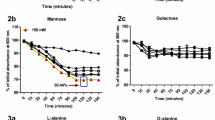Abstract
Incubation of unactivatedBacillus megaterium 14581 spores in glucose, or in glucose plusl-alanine, at or below pH 3.6 resulted in germination arrested somewhere before onset of stainability. However, triggering continued at this reduced pH, and spores thus triggered were fully capable of completing the germination sequence in the absence of the germinants once the pH was neutralized. The same spores could be triggered either by a mixture of glucose andl-alanine or by a larger concentration of glucose alone. From this it was concluded that triggering results from an adequate stimulus which can be generated in different ways.l-alanine action in triggering has a pH profile distinct from that of glucose, suggesting that these two germinants have different receptor sites as well. At a level of acidity at which a weak glucose concentration triggered relatively few spores, a much larger fraction was found apparently distributed over a range of sub-triggering levels. Some of these could be made to trigger on transfer to a secondary reagent, or mixture of reagents, which by themselves are not very efficient germinants of the strain studied. The degree of additional triggering was found to depend on the nature of the complementary germinants, as well as on the pH at which glucose stimulated them. Evidence that spores may occupy stimulated states for finite lifetimes is presented and discussed.
Similar content being viewed by others
Literature Cited
Bédard J, Lefebvre GM (1989)l-Alanine and inosine enhancement of glucose triggering inBacillus megaterium spores. Can J Microbiol 35:760–763
Blocher JC, Busta FF (1983) Bacterial spore resistance to acid. Food Technol 37:87–99
Blocher JC, Busta FF (1985) Inhibition of germinant binding by bacterial spores in acidic environments. Appl Environ Microbiol 50:274–279
Foerster HF, Foster JW (1966) Response ofBacillus spores to combinations of germinative compounds. J Bacteriol 91:1168–1177
Foster SJ, Johnstone K (1986) The use of inhibitors to identify early events duringBacillus megaterium KM spore germination. Biochem J 237:865–870
Foster SJ, Johnstone K (1987) Purification and properties of a germination-specific cortex-lytic enzyme from spores ofBacillus megaterium KM. Biochem J 242:573–579
Foster SJ, Johnstone K (1988) Germination-specific cortexlytic enzyme is activated during triggering ofBacillus megaterium KM spore germination. Molec Microbiol 2:727–733
Gould GW (1969) Germination. In: Gould GW, Hurst A (eds) The bacterial spore. London: Academic Press, pp 397–444
Harrell WK, Halvorson H (1955) Studies on the role ofl-alanine in the germination of spores ofBacillus terminalis. J Bacteriol 69:275–279
Lefebvre GM (1978) The time dependence of bacterial spore germination. J Theor Biol 75:307–326
Levinson HS, Hyatt MT (1966) Sequence of events duringBacillus megaterium spore germination. J Bacteriol 9:1811–1818
Rossignol DP, Vary JC (1978) Biochemistry ofl-proline-triggered germination ofBacillus megaterium spores. J Bacteriol 138:431–441
Scott IR, Ellar DJ (1978) Study of calcium dipicolinate release during bacterial spore germination by using a new sensitive assay for dipicolinate. J Bacteriol 135:133–137
Shibata H, Takamatsu H, Tani I (1976) Germination of unactivated spores ofBacillus cereus T. Effect of preincubation withl-alanine and inosine on the subsequent germination. Jpn J Microbiol 20:529–535
Stewart GSAB, Johnstone K, Hagelberg E, Ellar DJ (1981) Commitment of bacterial spores to germinate. A measure of the trigger reaction. Biochem J 198:101–106
Thorley CM, Wolf J (1961) Some germination factors in mesophilic spore formers. In: Halvorson HO (ed) Spores II. Minneapolis: Burgess Publishing Co, pp 1–13
Yasuda Y, Tochikubo K (1984) Relation betweend-glucose andl- andd-alanine in the initiation of germination ofBacillus subtilis spores. Microbiol Immunol 28:197–207
Author information
Authors and Affiliations
Rights and permissions
About this article
Cite this article
Morin, P., Bédard, J. & Lefebvre, G.M. Certain aspects of the pH dependence of triggering inBacillus megaterium spores. Current Microbiology 21, 349–354 (1990). https://doi.org/10.1007/BF02199436
Issue Date:
DOI: https://doi.org/10.1007/BF02199436




